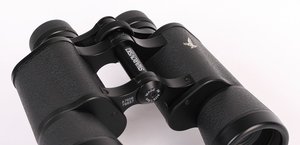Kowa Genesis 8x33
The parameters of the new Kowa products are impressive indeed. Every set of binoculars is constructed in the Schmidt-Pechan roof prism system; the prisms are covered by special C3 coating, offering a reflectance of 99% across the entire visible spectrum (400 to 700nm). Additionally the prisms are phase- coated. The producers weren’t skimpy on lenses of special kind either – in 33 mm class constructions there are as many as two low-dispersion Prominar XD lenses in each objective. The design of the binoculars is far from simple too. Each objective lens is apochromatic (as we mentioned it includes as many as two low-dispersion elements) and behind it there is a single focusing lens; then we get some prisms and a 4-element eyepiece.
Casings of this series of binoculars are made of magnesium alloys and are armoured by high quality rubber. The instruments are waterproof and nitrogen-purged. The buyer gets a rainguard, a tethered objective lens caps which can be attached to the inner tubes of the binoculars, a neck strap, a cleaning cloth and a stylish hard case included in box.
| Magnification | Lens diameter | Angular field of view | Prisms | Eye relief | Weight | Price |
|---|---|---|---|---|---|---|
| 8 | 33 | 140/1000(8o) | BaK-4/roof | 15 mm | 590 g | 3801 PLN |
Summary
Cons:
- casing is solid but relatively light and handy at the same time,
- very good transmission,
- good whiteness rendition,
- well-corrected chromatic aberration,
- very low astigmatism,
- slight coma,
- well-corrected distortion,
- wide field of view,
- good quality of prisms and coatings.
Cons:
- truncated exit pupils,
- the image at the edge of the field could have been sharper,
- not very sensible practice of putting ad slogans inside the binoculars’ inner tube,
- short guarantee period for this price segment.
 |
Let me start in a bit subjective way. Personally I like Kowa binoculars. They are always solidly made and stylishly designed – holding them in your hands and using them is a pleasure. It is true not only for the high-end Genesis series but also the lower BD series as well. What’s more, these binoculars manage to avoid many serious optics slip-ups so their purchase can be recommended practically on spec. It would be difficult not to be pleased with such a product.
The competition on the market is fierce, though, and the Kowa binoculars are definitely not cheap. How do they compare with their rivals? Do they have any edge over the other devices? Our test will answer these questions.
When it comes to the build quality of the casing we have no reservations whatsoever. Everything is fine apart from that unfortunate PROMINAR inscription inside the inner tube. I do wish I knew who came up with such a ludicrous idea. The binoculars are blackened inside because they have to be black, not to prepare a dark background for a light inscription…It is certainly not a serious flaw but nevertheless the device lost one point because of it in the blackening category.
It can be seen that the binoculars’ designers strived to get a small, physically light and handy instrument. They succeeded although the binoculars has the objective lens with a diameter of 33 mm so by 1-3 mm larger than other devices tested here by us. These compact dimensions backfired, though, because the prisms are a bit too small making the exit pupils distinctly egg-shaped.
The binoculars feature a huge field of view, even a bit wider than those officially declared 8 degrees – in fact it is a record-breaker in this class, among contemporary produced roof prism instruments. Once again, though, too much emphasis was put on the big field of view and with small dimensions and vignetting prisms, we get the edge not as sharp as we would expect as a result. The Kowa would be probably better off with the field of view of about 7.8 degrees. Nobody could criticize it for it being too narrow but its edge would look definitely better.
Our carping ends here because in the majority of important testing categories the Kowa reaches very good or even outstanding results. Let’s start with the transmission which graph is presented below.
 |
The maximum transmission level is reached in the wide area near the middle of the visible spectrum and amounts to 91-92% – a great performance indeed. What’s more, the graph is quite flat so the binoculars’ colour rendition is good.
The high quality of optics – its workmanship and layout- is confirmed by the results in such categories as astigmatism, coma or distortion. Also these low-dispersion elements do a good job here because the tested set of binoculars really corrects the chromatic aberration well.
To sum up everybody who has an opportunity to use the Kowa Genesis 8x33 will enjoy its performance and the images it provides. Whether it is worth almost 1000 Euro which you must pay for that pleasure is an open question though. In my opinion such an expensive device should have less disadvantages after all.

















